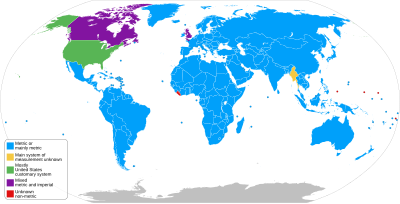
Back تاريخ النظام المتري Arabic মেট্রিক পদ্ধতির ইতিহাস Bengali/Bangla Historia del sistema métrico Spanish История метрической системы Russian

The history of the metric system began during the Age of Enlightenment with measures of length and weight derived from nature, along with their decimal multiples and fractions. The system became the standard of France and Europe within half a century. Other measures with unity ratios[Note 1] were added, and the system went on to be adopted across the world.
The first practical realisation of the metric system came in 1799, during the French Revolution, after the existing system of measures had become impractical for trade, and was replaced by a decimal system based on the kilogram and the metre. The basic units were taken from the natural world. The unit of length, the metre, was based on the dimensions of the Earth, and the unit of mass, the kilogram, was based on the mass of a volume of water of one litre (a cubic decimetre). Reference copies for both units were manufactured in platinum and remained the standards of measure for the next 90 years. After a period of reversion to the mesures usuelles due to unpopularity of the metric system, the metrication of France and much of Europe was complete by the 1850s.
In the middle of the 19th century, James Clerk Maxwell conceived a coherent system where a small number of units of measure were defined as base units, and all other units of measure, called derived units, were defined in terms of the base units. Maxwell proposed three base units for length, mass and time. Advances in electromagnetism in the 19th century necessitated additional units to be defined, and multiple incompatible systems of such units came into use; none could be reconciled with the existing dimensional system. The impasse was resolved by Giovanni Giorgi, who in 1901 proved that a coherent system that incorporated electromagnetic units required a fourth base unit, of electromagnetism.
The seminal 1875 Treaty of the Metre resulted in the fashioning and distribution of metre and kilogram artefacts, the standards of the future coherent system that became the SI, and the creation of an international body Conférence générale des poids et mesures or CGPM to oversee systems of weights and measures based on them.
In 1960, the CGPM launched the International System of Units (in French the Système international d'unités or SI) with six "base units": the metre, kilogram, second, ampere, degree Kelvin (subsequently renamed the "kelvin") and candela, plus 16 more units derived from the base units. A seventh base unit, the mole, and six other derived units were added later in the 20th century. During this period, the metre was redefined in terms of the speed of light, and the second was redefined based on the microwave frequency of a caesium atomic clock.
Due to the instability of the international prototype of the kilogram, a series of initiatives were undertaken, starting in the late 20th century, to redefine the ampere, kilogram, mole and kelvin in terms of invariant constants of physics, ultimately resulting in the 2019 redefinition of the SI base units, which finally eliminated the need for any physical reference artefacts—notably, this enabled the retirement of the standard kilogram.
A fleeting hint of an ancient decimal or metric system may be found in the Mohenjo-Daro ruler, which uses a base length of 1.32 inches (33.5 mm) and is very precisely divided with decimal markings. Bricks from that period are consistent with this unit, but this usage appears not to have survived, as later systems in India are non-metric, employing divisions into eighths, twelfths, and sixteenths.
Cite error: There are <ref group=Note> tags on this page, but the references will not show without a {{reflist|group=Note}} template (see the help page).
© MMXXIII Rich X Search. We shall prevail. All rights reserved. Rich X Search